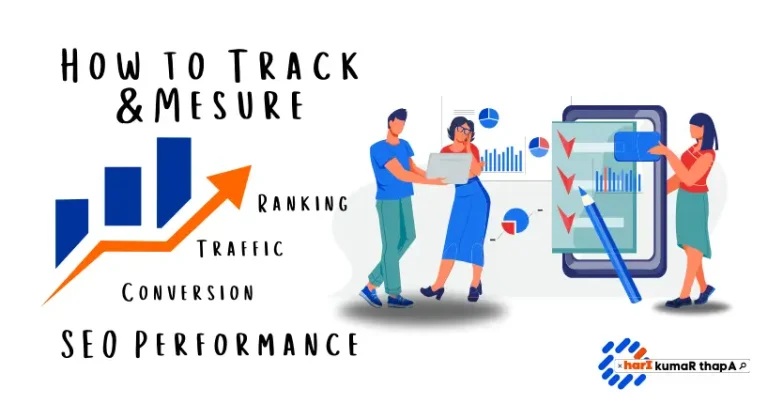Search Engine Optimization is an ongoing process but many SEO professional focus only on strategies like keyword research, content creation, and backlink building.
But fail to measure their performance which can bring a major disaster to your SEO campaign with tons of missed opportunities.
If you are one of them who does not know which Key Performance Indicator (KPI) to track, I’ve listed below top 7 Key Metrics to measure to better understand your visitors.
Keyword Position
Keyword position refers to your web page’s position on the Search Engine Results Pages (SERPs) for a particular keyword or search query.
The higher your ranking, the better your traffic potential, so you want to monitor your keywords.
Monitoring your keyword position can help you understand sudden spikes or drops in your website’s traffic. By regularly tracking how your keywords perform on search engine results pages, you can identify unexpected changes in your website’s visibility.
This allows you to investigate the causes and take appropriate actions to maintain or improve your website’s performance and ensure a steady traffic flow.
It is important to monitor your ranking because it changes frequently for several reasons, including:
- Google Algorithm / Search Engine update
- Losing Backlinks
- Competitor
- A technical error on your page, etc
Multiple SEO tools include free-to-track keyword positions like Semrush, Ahref, Google Search Console, Ubersuggest, and more.
Impression
An impression in SEO refers to the number of times your website link appears in the search results for a specific query.
Optimizing your content with the right keywords matching search intent is one way to get more search visibility.
You can monitor search impressions of your specific pages or keywords through Google Search Console for free or use tools like Ahref or SemRush.
Follow the steps to check how much impression your article/webpage gets:
- Go to your Search Console
- Performance
- Choose Queries or Pages to view.
CTR
Click-through rate (CTR) is the percentage of users who click on your website from a search engine. It is calculated as (Clicks/Impressions) * 100.
It is an important metric to measure, as targeting the right keywords, ranking on top, and getting tons of impressions are not enough if they are not clicking on your link.
If your CTR is low, there are 2 possibilities: your ranking is low, or your Headings and Meta Descriptions are not appropriately optimized.
You can check the click-through rate percentage from the search console for free. Follow the steps below:
- Login to your Google Search Console.
- Click on the Performance tab on the left.
- Select “Average CTR”
- You can also compare data based on Country, Device, or Search appearance.
Organic Traffic
The primary goal of every SEO campaign is to attract organic traffic from search engines, as it is a sustainable, long-term, and cost-effective way to reach a targeted audience.
After securing the keyword’s organic position in SERP, getting impressions, and optimizing your content for higher CTR, you now work to maintain your organic traffic.
No Organic Traffic = SEO Not Working, which is why traffic is one of the main metrics for SEO success.
You can check how many page views you get, unique visitors, and returning visitors.
You can track organic traffic for free tools like Google Analytics 4.
Follow the steps below to track organic traffic for free:
- Login to Google Analytics.
- Click on Report location on the tab.
- Now, choose Life Cycle and tap on Acquisition.
- Select “Traffic acquisition” to view traffic and its sources.
Conversion
Conversion is the completion of the desired action on a website.
It can be anything like subscribing to a newsletter, requesting a quote, downloading e-books, signing up for a service, purchasing a product, watching, or clicking on an affiliate link.
This is the final goal for all SEOs: making money by converting your visitors into Leads or Customers.
Conversions clearly indicate how well a website is performing in achieving its goals. This is why it is one of the most important metrics to watch.
You can track how many people from organic search converted using Google Analytics by logging in to GA 4 and then clicking on “Reports” > “Acquisition” > “Traffic acquisition.”
Bounce Rate
Bounce rate is the percentage of visitors who leave a website after viewing just one page without engagement. It is an important metric for measuring your SEO performance as it reveals weaknesses in your SEO strategies.
5 common reasons for a high bounce rate:
- Content does not match the user’s intent.
- Fails to provide helpful content.
- Error on your website (site health)
- Poor Navigation.
- Slow loading (Use leaving before your website loads)
- Poor mobile optimization (Not responsive)
You can audit pages where the most number of visitors leave without engagement and easily fix on-page or technical SEO improvements.
4 steps to Monitor the Bounce Rate using the GA 4 tool for free:
- Go to Google Analytics, then “Reports” > “Life cycle” > “Engagement” > “Pages and screens.”
- Click the pencil icon to customize your report location on the top left.
- Select “Metrics” from the “Report Data” and click on the “Add metric.”
- Choose “Bounce rate” from the drop-down and hit “Apply.”
Backlink
Backlink or Link building is one of the most important SEO metrics for tracking your SEO performance and ranking on the first page of Google’s search results.
High-quality backlinks can improve search engine visibility and a website’s position in search engine results pages (SERPs).
Search engines consider backlinks to be votes of confidence in the content.
Tools like Ahref, Semrush, Ubersuggest, and GSC provide free backlink check tools to get an idea of how your link building is going.





